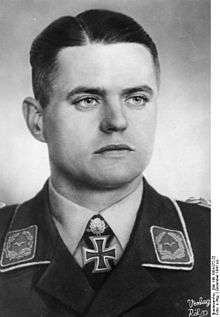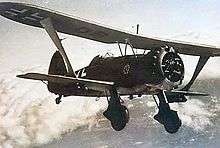Otto Weiß (pilot)
| Otto Weiß | |
|---|---|
 Otto Weiß | |
| Nickname(s) | Lion of Kalinin[1] |
| Born |
25 September 1907 Breslau |
| Died |
19 August 1955 (aged 47) Kiel |
| Allegiance |
|
| Service/branch |
Polizei Luftwaffe |
| Years of service | 1926–45 |
| Rank | Oberst |
| Unit | JG 134, LG 2, Luftflotte 6 |
| Commands held | SG 1 |
| Battles/wars | |
| Awards | Knight's Cross of the Iron Cross with Oak Leaves |
Otto Albert Bernhard Weiß[Note 1] (25 September 1907 – 19 August 1955) was a German World War II Luftwaffe attack aircraft pilot and recipient of the coveted Knight's Cross of the Iron Cross with Oak Leaves (German: Ritterkreuz des Eisernen Kreuzes mit Eichenlaub). The Knight's Cross of the Iron Cross and its higher grade Oak Leaves was awarded to recognise extreme battlefield bravery or successful military leadership. He was the first attack aircraft pilot so honored. Weiß flew more than 500 combat missions with the Henschel Hs 123 and the Messerschmitt Bf 109.[2]
Early and career
Weiß was born on 25 September 1907 in Breslau—today Wrocław in Poland—at the time a Silesian Province of the Kingdom of Prussia. He joined the police force (Polizei) of the Weimar Republic on 15 April 1926 at police school in Frankenstein in Schlesien and was promoted to Polizei-Leutnant in 1931. He transferred to the Deutsche Verkehrsfliegerschule (German Air Transport School) in Braunschweig for pilot training on 1 March 1933. Weiß transferred to the Luftwaffe on 1 October 1934 holding the rank of Oberleutnant where he initially served as a technical officer with a reconnaissance squadron. From October 1936 to July 1938, now a Hauptmann (Captain), he served on the Stab of Jagdgeschwader 134 "Horst Wessel" (JG 134—134th Fighter Wing).[Note 2] In July 1938 he was appointed Staffelkapitän (Squadron Commander) of the Fliegergruppe 40 (40th Flyers Group) which was later renamed to II.(S)/Lehrgeschwader 2 (II.(S)/LG 2—2nd Group (Ground Attack) of the 2nd Demonstration Wing).[3]
World War II

Shortly after the outbreak of World War II, on 13 September 1939, during the Invasion of Poland, he took command on the II.(S)/LG 2 following the death of its commander, Major Georg Spielvogel.[3] For his services during the Polish Campaign he received both classes of the Iron Cross. During the Battle of France in 1940 as part of the VIII. Fliegerkorps (8th Air Corps), he supported the German advance of the 6th Army in its crossing of the Meuse river and successfully supported the repulse of a French armoured attack south-east of Cambrai. Weiß and his group were stationed roughly 6 kilometres (3.7 mi) north of Cambrai at the time. A German reconnaissance aircraft, a Heinkel He 46, had spotted a French armoured column of 50 tanks supported by 150 trucks and infantry on the advance. Weiß organized the defense and led the attack from his Henschel Hs 123 ground attack aircraft. He had also informed the neighbouring fighter pilot group I./Jagdgeschwader 21 (JG 21—21st Fighter Wing) under the command of Hauptmann Fritz Ultsch. The two groups were further supported by anti-aircraft artillery from I./Flak-Regiment 33. The combined German units under Weiß's leadership were credited with the destruction of 40 French tanks.[4] For these achievements in the Battle of Montcornet, he was awarded the Knight's Cross of the Iron Cross on 18 May 1940, the first attack aircraft pilot so honored.[5] On 1 July 1940 Weiß was promoted to Major.[5]
Following the conversion to the Messerschmitt Bf 109 at Braunschweig-Waggum, the Gruppe was tasked to attack various targets in Southern England during the Battle of Britain. The Gruppe was augmented again in early 1941 with a Staffel of Hs 123 ground attack aircraft. In the Invasion of Yugoslavia in April 1941, II.(S)/LG 2 was deployed with two squadrons Bf 109 and one squadron Hs 123. With the start of Operation Barbarossa, the German invasion of the Soviet Union in June 1941, the Gruppe, consisting of three squadrons Bf 109 and one Hs 123, was again subordinated to the VIII. Fliegerkorps and fought in the central sector of the Eastern Front.[5] In January 1942 the II(S)./LG 2 was re-designated and became the core of Schlachtgeschwader 1 (SG 1—1st Ground Attack Wing). Otto Weiß was appointed its first Geschwaderkommodore (Wing Commander).[6]
Otto Weiß surrendered command of SG 1 to Hubertus Hitschhold on 18 June 1942. He was then tasked with experimenting with anti-tank warfare from the air. An experimental unit dubbed Versuchskommando für Panzerbekämpfung (experimental commando for anti-tank combat) was founded at Rechlin experimenting with the Junkers Ju 87 and Henschel Hs 129 in an anti-tank role. Weiß was promoted to Oberst (Colonel) on 1 November 1943 and served in the staff of Luftflotte 6 (Air Fleet 6) until the end of World War II.[6] He died in Kiel on 19 August 1955 following a lengthy illness.[7]
Awards
- Iron Cross (1939)
- Knight's Cross of the Iron Cross with Oak Leaves
- Mentioned in the Wehrmachtbericht on 18 May 1940?[Note 5]
Notes
- ↑ His name, in German, is spelled with a "sharp S"; see ß.
- ↑ For an explanation of Luftwaffe unit designations see Organisation of the Luftwaffe during World War II.
- ↑ According to Brütting on 15 September 1939.[5]
- ↑ According to Brütting on 2 October 1939.[5]
- ↑ According to Thomas he was mentioned in the Wehrmachtbericht on 18 May 1940.[8] However there is no reference of him in the Wehrmachtbericht on 18 May 1940 itself.[12]
References
Citations
- ↑ Weal 2003, p. 36.
- ↑ Obermaier 1976, p. 55.
- 1 2 Obermaier 1976, p. 54.
- ↑ Brütting 1992, p. 138.
- 1 2 3 4 5 Brütting 1992, p. 139.
- 1 2 Brütting 1992, p. 140.
- ↑ Kurowski 1996, p. 160.
- 1 2 3 Thomas 1998, p. 427.
- 1 2 Scherzer 2007, p. 775.
- ↑ Fellgiebel 2000, p. 440.
- ↑ Fellgiebel 2000, p. 56.
- ↑ Die Wehrmachtberichte 1939–1945 Band 1, pp. 156–159.
Bibliography
- Brütting, Georg (1995). Das waren die deutschen Stuka-Asse 1939 – 1945 [These were the German Stuka Aces 1939 – 1945] (in German). Stuttgart, Germany: Motorbuch. ISBN 978-3-87943-433-6.
- Fellgiebel, Walther-Peer (2000) [1986]. Die Träger des Ritterkreuzes des Eisernen Kreuzes 1939–1945 — Die Inhaber der höchsten Auszeichnung des Zweiten Weltkrieges aller Wehrmachtteile [The Bearers of the Knight's Cross of the Iron Cross 1939–1945 — The Owners of the Highest Award of the Second World War of all Wehrmacht Branches] (in German). Friedberg, Germany: Podzun-Pallas. ISBN 978-3-7909-0284-6.
- Fellgiebel, Walther-Peer; C. F., Colton; Rogers, Duncan (2003). Elite of the Third Reich: the recipients of the Knight's Cross of the Iron Cross, 1939–45. Helion & Company Limited. ISBN 978-1-874622-46-8.
- Kurowski, Franz. Luftwaffe Aces. Winnipeg: J.J. Fedorowicz Publishing Inc., 1996. ISBN 0-921991-31-2.
- Obermaier, Ernst (1976). Die Ritterkreuzträger der Luftwaffe 1939–1945 Band II Stuka- und Schlachtflieger [The Knight's Cross Bearers of the Luftwaffe 1939–1945 Volume II Dive Bomber and Attack Aircraft] (in German). Mainz, Germany: Verlag Dieter Hoffmann. ISBN 978-3-87341-021-3.
- Scherzer, Veit (2007). Die Ritterkreuzträger 1939–1945 Die Inhaber des Ritterkreuzes des Eisernen Kreuzes 1939 von Heer, Luftwaffe, Kriegsmarine, Waffen-SS, Volkssturm sowie mit Deutschland verbündeter Streitkräfte nach den Unterlagen des Bundesarchives [The Knight's Cross Bearers 1939–1945 The Holders of the Knight's Cross of the Iron Cross 1939 by Army, Air Force, Navy, Waffen-SS, Volkssturm and Allied Forces with Germany According to the Documents of the Federal Archives] (in German). Jena, Germany: Scherzers Militaer-Verlag. ISBN 978-3-938845-17-2.
- Thomas, Franz (1998). Die Eichenlaubträger 1939–1945 Band 2: L–Z [The Oak Leaves Bearers 1939–1945 Volume 2: L–Z] (in German). Osnabrück, Germany: Biblio-Verlag. ISBN 978-3-7648-2300-9.
- Weal, John (2003). Luftwaffe Schlachtgruppen. Oxford, UK: Osprey Publishing. ISBN 978-1-84176-608-9.
- Die Wehrmachtberichte 1939–1945 Band 1, 1. September 1939 bis 31. Dezember 1941 [The Wehrmacht Reports 1939–1945 Volume 1, 1 September 1939 to 31 December 1941] (in German). München, Germany: Deutscher Taschenbuch Verlag GmbH & Co. KG. 1985. ISBN 978-3-423-05944-2.
| Military offices | ||
|---|---|---|
| Preceded by none |
Commander of Schlachtgeschwader 1 January 1942 – 18 June 1942 |
Succeeded by Oberleutnant Hubertus Hitschhold |
